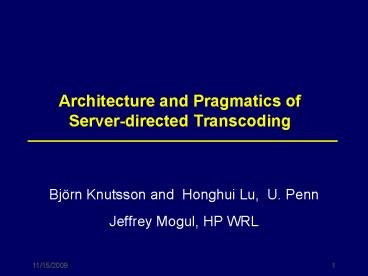Architecture and Pragmatics of Serverdirected Transcoding - PowerPoint PPT Presentation
1 / 26
Title:
Architecture and Pragmatics of Serverdirected Transcoding
Description:
Basic architecture. Server-directives as mobile code applets ... Basic, un-optimized implementation. No caching of either image or transcoding applet ... – PowerPoint PPT presentation
Number of Views:35
Avg rating:3.0/5.0
Title: Architecture and Pragmatics of Serverdirected Transcoding
1
Architecture and Pragmatics of Server-directed
Transcoding
- Björn Knutsson and Honghui Lu, U. Penn
- Jeffrey Mogul, HP WRL
2
Transcoding proxies
- Problems that transcoding proxies solve
- Complex server content
- Highly variable network bandwidths
- Highly variable client capabilities screen size,
color depth, encoding
Origin Server
Transcoding Proxy
3
Problem with transcoding proxies
Q50, 5831 bytes
JPEG, 200x267 Q34, 5815 bytes
JPEG, 600x800 Q3, 5830 bytes
JPEG, 600x800 Q50, 48617 bytes
4
Server-directed transcoding (SDT)
- Autonomous transcoding
- Proxy employs heuristics
- Risks loosing the meaning of the content
- Risks loosing opportunities for aggressive
transcoding - Server-directed transcoding
Mogul WCW 00 - Server explicitly tells the proxy what to do
- Respects the end-to-end argument
5
Contributions
- A specific protocol design
- An applet architecture
- A proxy architecture
- Interesting transcoding applets
- Experimental results
6
Basic architecture
- Server-directives as mobile code applets
- Reference to applets attached to the HTTP response
Request
Request
Origin Server
Transcoding Proxy
Client
Response directives
Transcoded response
Fetch applet
- Size and reusability of applets?
7
HTTP protocol extensions
- New HTTP response headers
- No restrictions on the syntax of SDT-parms
- SDT-parms are interpreted by applets, not by
proxies - Mechanism for reusing applets
SDT-applet http//example.com/crop.jar SDT-parms
crop-origin140300, crop-size100,100
8
Basic image transformations
- Cropping
- Scaling
- Lossy compression
- Color-depth reduction
- De-animation
- Format conversion
- New basic transformations may be introduced
9
Complex image transformations
- An image must be adapted for many clients
- Small screen
- Cropping, scaling
- Low bandwidth
- Cropping, color-depth reduction, scaling
- Lossy compression, de-animation
- Small screen and low bandwidth?
10
What should an applet look like?
- Big, all inclusive applet
- Control complexity
- Small, per image applet
- Reusability
- Category-specific applet
- One applet that applies to a set of images
11
Example applet 'crop-interp'
- For images with one important subject and
surroundings that just add flavour
- First interpolate between a set of crop boxes
- Shrinks the inner most cropped image if necessary
12
Other category-specific applets
- Landscape panorama
- Apply lossy compression first
- Then crop
- Banner ad
- Reduce color depth first
- De-animation, scaling
13
Who is in control?
- Seems the server controls everything, via the
applet - But, what if
- Server image cannot be scaled to lt 100x100
- Client cannot display images gt 50x50
- Proxy does not have enough CPU cycles for this!
- Who decides what transformations to apply?
14
Who is in control of what?
- Origin server controls the semantics
- Client controls the presentation
- Proxy controls the resource used for transcoding,
and network traffic - Server controls are delegated to its applet
running at proxy
15
Rules for resolving conflicts
- Any party has a veto
- Server or proxy can decide not to transcode an
image - The client can decide to reject an image
- Server is free to compromise semantics in order
to meet client and proxy preferences, if the
server is willing
16
Proxy environment
Client parameters
SDT-parms
Transcoded response
Transcoding applet
response
Proxy parameters
17
Revisit crop-interp
- For images with a main subject
- Simple control
Crop-interp(input image, output image,
SDT_params, / crop boxes /
client parameters, proxy parameters)
18
The pragmatics of an applet
- Applet size is still large
- Image I/O
- Bit manipulations for basic transformations
- Performance is bad
- Compute intensive
- Interpreted code is slow
19
The pragmatics of an applet
- Separate common, basic functions from the control
Function applet
Control applet 2
Control applet 1
- Implement basic functions with native code
20
Prototype proxy implementation
- Basic, un-optimized implementation
- No caching of either image or transcoding applet
- Sequential store and forward
- Implemented in Perl
- Supports Perl applets
- Pre-installs native functions (ImageMagick)
- Long-term augment Squid to support Java applets
21
Experimental environment
- Penn CIS Web server
- Proxy IBM ThinkPad, 1.2GHz Pentium III, 384MB
RAM - 10 Mbps Ethernet between server and proxy
- Simulate various proxy-to-client bandwidths using
Linux Traffic Shaper
22
Transcoding overhead
- crop-interp 2KB Perl code
- Original image 600x800, 65982 bytes
- Target size 200x267, 5831 bytes
- Download applet 30ms
- Execute applet 86ms
23
Effect on end-to-end latency (ms)
24
Summary of contributions
- A specific protocol design
- An applet architecture
- A proxy architecture
- Interesting transcoding applets
- Experimental results
- Improves end-to-end latency even on 768 Kbps links
25
Future work
- Applet design
- Size, reusability, performance
- Proxy execution environment
- Native functions
- API
- Security issues
- Resource consumption of transcoding applets
- Caching issues
- cache replacement policy
- Matching client requests with the cached items
- Transform contents other than images
- Extend to support CDNs and streaming media
26
Related work
- Proxy transcoding
- Brooks et al. 1995, Fox et al. 1996
- Chandra and Ellis 1998
- Introducing code into proxy
- Active Cache, Cao et al. 1998
- Active Names, Vahdat et al. 1999
- Other related ideas
- Active networking
- IBM WebSphere
- ICAP

